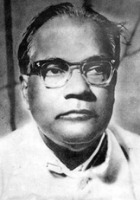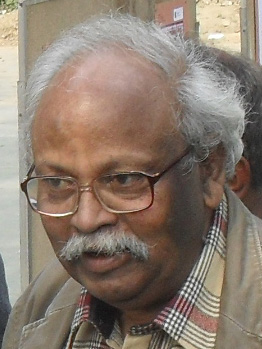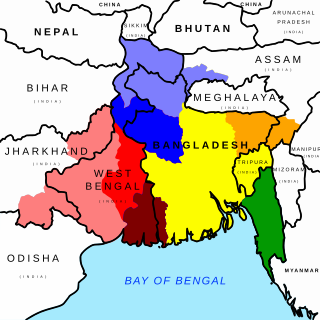
Muhammad Shahidullah was a Bengali linguist, philologist, educationist, and writer.

Manikganj is a district in central Bangladesh. It is a part of the Dhaka Division, In 1845 AD it was at first declared as a sub-division. It was at first, under Faridpur district then it was included under Dhaka district in 1956 for the administrative purposes. In 1984 Manikganj was declared as a full district.

Zainul Abedin, also known as Shilpacharya was a prominent Bangladeshi painter. He became well known in 1944 through his series of paintings depicting some of the great famines in Bengal during its British colonial period. After the Partition of Indian subcontinent he moved to East Pakistan. In 1948, he helped to establish the Institute of Arts and Crafts at the University of Dhaka. The Indian Express has described him as a legendary Bangladeshi painter and activist. Like many of his contemporaries, his paintings on the Bengal famine of 1943 are viewed as his most characteristic works. His homeland honored him with given the title "Shilpacharya" "Great teacher of the arts" for his artistic and visionary attributes. He was the pioneer of the modern art movement that took place in Bangladesh and was rightly considered by Syed Manzoorul Islam as the founding father of Bangladeshi modern arts, soon after Bangladesh earned the status of an independent republic.

Sheikh Mohammed Sultan, popularly known as S M Sultan, was a Bengali decolonial artist who worked in painting and drawing. His fame rests on his striking depictions of exaggeratedly muscular Bangladeshi peasants engaged in the activities of their everyday lives. Sultan's early works were influenced by western technics and forms, particularly impressionism, however, in his later works particularly, works exhibited in 1976, we discover there is a constant temptation to decolonize his art technics and forms.

Dhaka College also known as DC is the oldest educational institution of Bangladesh located in Dhanmondi, Dhaka 1205. It offers higher secondary education (HSC). It has Honours and Master's programs as well which are affiliated with the University of Dhaka.

Maulana Azad College is a public institute of liberal arts, commerce and science in India, located in central Kolkata, West Bengal, India. The college is fully government-administered. It is located near the junction of Rafi Ahmed Kidwai Road and SN Banerjee Road, popularly called "Lotus crossing".

Golam Mostofa was a Pakistani Bengali writer and poet.
Qazi Imdadul Haq (1882–1926) was a Bengali writer.

Rafiqun Nabi, better known as Ranabi, is a Bangladeshi artist and cartoonist. He is best known for creating Tokai, a character symbolizing the poor street boys of Dhaka who lives on picking things from dustbins or begging and having a knack of telling simple yet painful truths about current political and socio-economic situation of the country. He was awarded Ekushey Padak in 1993 by the government of Bangladesh.

Dhaka (Dacca) is one of the oldest inhabited mega cities of the World. The history of Dhaka begins with the existence of urbanised settlements in the area that is now Dhaka dating from the 7th century CE. The city area was ruled by the Hindu Gauda Kingdom, Buddhist and Shaivite Pala Empire before passing to the control of the Hindu Sena dynasty in the 10th century CE. After the Sena dynasty, the city was ruled by the Hindu Deva Dynasty. Dhaka was successively ruled by the Turkic and Afghan governors descending from the Delhi Sultanate, followed by the Bengal Sultanate, before the arrival of the Mughals in 1608. The city became proto-industrialised and declared capital of the Mughal Bengal and commercial (financial) capital of the Mughal India. The Dhaka natural riverine port has a recorded existence since the 16th century CE. Dhaka's strategic riverine location in Bengal made it a hub for Eurasian traders, including Armenians, the Portuguese, French, Dutch and British. The bustling old city was known as the Venice of the East. After Mughals, British ruled the region for 200 years until the independence of India in 1947. After the independence of Bangladesh in 1971, Dhaka became the capital of the new state.

Shahbagh is a major neighbourhood and a police precinct or thana in Dhaka, the capital and largest city of Bangladesh. It is also a major public transport hub. It is a junction between two contrasting sections of the city—Old Dhaka and New Dhaka—which lie, respectively, to its south and north. Developed in the 17th century during Mughal rule in Bengal, when Old Dhaka was the provincial capital and a centre of the flourishing muslin industry, it came to neglect and decay in early 19th century. In the mid-19th century, the Shahbagh area was developed as New Dhaka became a provincial centre of the British Raj, ending a century of decline brought on by the passing of Mughal rule.

Rashid Hossain Choudhury was a Bangladeshi second generation artist, sculptor, writer and professor. He played a major part in the art movements and improvement in the art-related educational institutions of Bangladesh. He has received numerous awards and recognition for creative contribution and innovative influence. During the 1950s, he had been a significant pioneer in the modern art movement in Bandladesh.

The culture of Bengal defines the cultural heritage of the Bengalis or Bangali people native to eastern regions of the Indian subcontinent, mainly what is today the independent state of Bangladesh and the Indian states of West Bengal, Tripura, Assam and Jharkhand, where the Bengali (Bangla) language is the national, the official and the additional official language. The Bengal has a recorded history of 3,100 years.

Hakim Habibur Rahman (23 March 1881 – 23 February 1947) was an Unani physician, litterateur, journalist, politician and chronicler in early 20th-century Dhaka, British India.

Bangladeshi art is a form of visual arts that has been practiced throughout the land of what is now known as Bangladesh. Bangladeshi art has a perennial history which originated more than two thousand years ago and is practiced even to this date. Among the various forms of Bangladeshi art, photography, architecture, sculpture and painting are the most notable.
Muhammad Mansuruddin was a Bengali author, literary critic, essayist, lexicographer and biographer from Bangladesh. He was an authority on folklore and was famous for a huge collection of age-old folk songs, mostly anthologised in thirteen volumes under the title Haramoni. In recognition of his lifelong contribution to folklore collection and research, the Rabindra Bharati University awarded him D.Litt. degree in 1987.
Abū al-Khayr Muḥammad Ayyūb ʿAlī al-Māturīdī, or simply Ayub Ali, was a Bangladeshi Islamic scholar, author and educationist. He was awarded the Ekushey Padak in 1976 by the Government of Bangladesh.
Syed Murtaza Ali was a Bangladeshi writer. He was the elder brother of writer and linguist Syed Mujtaba Ali. He is noted for his works relating to the histories of Chittagong, Sylhet and Jaintia.
Syed Azizul Huq, also known by his daak naam Nanna Mia, was a Bangladeshi politician and former Member of Parliament from Barisal-2 in 1986 and 1988 Bangladeshi general election. He was a member of the Provincial Council of East Pakistan, Minister of Commerce and Minister of Industry.
Maulawi Āghā Aḥmad ʿAlī was a 19th-century Bengali academic, historian and scholar of the Persian language. In addition to Persian, he also composed poetry in Urdu. He is seen as one of the greatest Persian scholars of Dhaka, and even Bengal as a whole.













